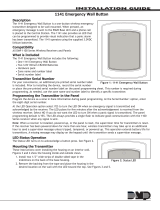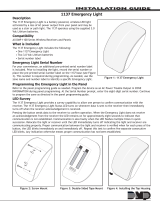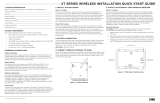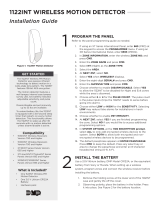Page is loading ...

After the transmitter has been programmed into the panel,
install the batteries. Use only 3.0V lithium batteries, DMP
Model CR123A, or the equivalent battery from a local retail
outlet. Keep in mind, when setting up a wireless system, program
zones and connect the receiver before installing batteries in the
transmitters.
1. Remove the cover by pushing the button on the end of the
cover and gently pulling upwards.
2. Observing polarity, place the battery in the holder and press
into place.
1115 WIRELESS TEMPERATURE
SENSOR AND FLOOD DETECTOR
Installation Guide
1
LT-1547 © 2017 Digital Monitoring Products, Inc.
17083
The 1115 Wireless Temperature
Sensor and Flood Detector is
designed to be used in a variety
of applications that help protect
against temperature fluctuations
and flood conditions. The 1115 has
an internal temperature sensor that
can be set to detect cold, hot, or
warm temperature ranges.
When combined with the
remote T280R temperature
probe, the 1115 can be set to
monitor refrigerated or freezing
temperatures.
The 1115 can also be paired with
the remote 470PB water sensor
and used in situations where flood
detection is necessary.
Depending on a customer’s needs,
the 1115 can be programmed with
up to four zones and serve as a
temperature sensor, flood detector,
or both simultaneously.
Compatibility
All DMP 1100 Series Wireless
Receivers and burglary
panels. See the last page for
compatibility details.
What is Included?
One 1115 PCB mounted in a
two‑part housing
One 3V lithium CR123A battery
One 2MΏ EOL resistor
Mounting screws
Figure 1: 1115 Wireless
Temperature Sensor and
Flood Detector
DESCRIPTION
PROGRAM THE PANEL
The 1115 Wireless Temperature Sensor and Flood Detector can
be programmed with up to four zones. When programming
the 1115 in the panel, refer to the panel programming guide as
needed.
Note: When a wireless receiver is installed, powered down and
powered up, the panel is reset, or programming is complete, the
supervision time is reset. If the receiver has been powered down for
more than one hour, the 1115 may take up to an additional hour to
send a supervision message unless tripped, tampered, or powered
up. This operation extends battery life. A missing message may
display on the keypad until the supervision message is sent.
1. In ZONE INFORMATION, enter the ZONE number and
press CMD.
Note: Zones must be entered sequentially. For example, if you
begin by programming zone 71, you would need to program
zone 72 as the next contact.
2. Enter the ZONE NAME and press CMD.
3. Select SV (Supervisory) as the Zone Type and press CMD.
4. At the NEXT ZONE prompt, select NO. If you see the
WIRELESS ZONE prompt, select YES.
5. Enter the eight‑digit SERIAL NUMBER and press CMD.
6. Enter the CONTACT number being used.
Note: Contacts can be entered in any order. Refer to Table 1
to select the correct contact.
7. Enter the SUPRVSN TIME and press CMD.
8. At the NEXT ZONE prompt, select YES and continue to
program up to three more zones.
Note: For the 1115’s tamper feature to be enabled, contact 1 must be
programmed as a zone in the control panel.
INSTALL THE BATTERIES
2

SET THE DIP SWITCHES
4
1115 INSTALLATION GUIDE | DIGITAL MONITORING PRODUCTS 2
SELECT A LOCATION
The 1115 provides a survey capability to allow one
person to confirm communication with the wireless
receiver or panel while the cover is removed. This
allows you to easily determine the best location for the 1115.
Be sure to choose a location on a flat wall or single‑gang box
away from large metal objects.
1. Hold the 1115 in the exact desired location.
2. Press the tamper switch to send data to the receiver and
determine if communication is confirmed or faulty. See
Figure 2 for tamper switch and LED locations.
Confirmed: If communication is confirmed, the
survey LED turns on when data is sent to the
receiver and o when acknowledgement is
received.
Faulty: If communication is faulty, the LED remains
on for about 8 seconds or flashes multiple times in
quick succession.
3. Relocate the 1115 or receiver until the LED confirms clear
communication. Proper communication between the 1115
and receiver is verified when for each press or release of
the tamper switch, the LED blinks immediately on and
immediately o.
3
The 1115 has four DIP switches (labeled 1 through 4) located on the PCB. Cold and flood settings
can be turned on or o. Hot/warm and freeze/refrigerate are either‑or settings. Refer to Table 1 and
Figure 2 for DIP switch setting options and operations:
OPERATION
DIP SWITCH
POSITION
CONTACT
ALARM OCCURS
WHEN
ZONE RESTORES
WHEN
SENSOR
Cold 1 = ON 1
Temperature drops below 45°F for
>10 minutes
Temperature rises above 48°F
for > 4 minutes
Internal
Hot 2 = OFF 2
Temperature rises above 95°F for
> 10 minutes
Temperature drops below
92°F for > 4 minutes
Internal
Warm 2 = ON 2
Temperature rises above 75°F for
> 10 minutes
Temperature drops below
72°F for > 4 minutes
Internal
Freezer 3 = OFF 3
Temperature rises above 10°F for
> 30 minutes
Temperature drops below 7°F
for > 4 minutes
External (T280R)
Refrigerator 3 = ON 3
Temperature rises above 42°F for
> 30 minutes
Temperature drops below
39°F for > 4 minutes
External (T280R)
Flood 4 = ON 4
Probe tips are in contact with
water for > 3 minutes
Probe tips have not been in
water for > 3 minutes
External (470PB)
Table 1: DIP Switch Settings and Operation
T
C F
Survey
LED
Tamper
Switch
Figure 2: Tamper Switch,
Survey LED, and DIP Switches
ON
1 2 3 4
OFF

T
C F
SENSOR PROBES
Terminal Block
Optional
Mounting Hole
Mounting
Hole
Figure 5: Mounting Holes
and Terminal Block
WIRE THE SENSOR PROBES (Optional)
5
If freezer or refrigerator sensing functionality is required,
connect a T280R temperature sensor probe. If flood
sensing functionality is required, connect a 470PB water
sensor probe. When connecting a remote probe to the terminal
block, DMP recommends using 18 or 22‑gauge unshielded wire. Do
not use twisted pair or shielded wire. Use no more than 150 feet of
22‑gauge wire, or no more than 200 feet of 18‑gauge wire.
Connect the 470PB Water Sensor Probe
To use the 470PB, place the probe inside the area and run 18 or
22‑gauge unshielded wire to the 1115. Follow these steps to connect
the wire to the 1115 terminals:
1. Connect a wire from the top of one of the sensor’s probes to
the F terminal on the 1115 PCB by running it through the wiring
opening in the housing. See Figures 3 and 5.
2. Connect a wire from the top of the other probe to the C
terminal on the 1115 PCB by running it through the wire
opening in the housing.
3. Connect a 2MΏ EOL resistor (included with the 1115) between
the two 470PB water sensor probes.
Connect the T280R Temperature Sensor Probe
To use the T280R, place the probe inside the refrigerator or freezer
environment and run 18 or 22‑gauge unshielded wire to the 1115. The
T280R has a built‑in EOL resistor. No additional EOL resistor should
be used. Follow these steps to connect the wire to the 1115 terminals:
1. Connect the white wire to the T terminal on the 1115 PCB
by running it through the wire opening in the housing. See
Figures 4 and 5.
2. Connect the black wire to the C terminal on the 1115 PCB by
running it through the wire opening in the housing.
MOUNT THE 1115
6
It is recommended the sensor be mounted on a flat wall
away from large metal objects. Do not mount the 1115 inside
of freezers or walk‑in refrigerators. In those situations, use
the optional remote T280R temperature probe.
1. Hold the transmitter base on the wall and place one screw into
the mounting hole location shown in Figure 5 and secure the
housing to the surface.
Note: You can place an additional screw in the optional
mounting hole if needed.
2. Snap the transmitter housing cover back on the base.
Connect to
Terminal F
Figure 3: 470PB Water
Sensor Probe
Connect to
Terminal C
2MΏ EOL Resistor
Figure 4: T280R Temperature
Sensor Probe
Connect to
Terminal C
Connect to
Terminal T
1115 INSTALLATION GUIDE | DIGITAL MONITORING PRODUCTS 3
Wire Opening

REPLACE THE BATTERY
1. Remove the cover by pushing the button on the end of the cover and gently pulling upwards.
2. Remove the old battery and dispose of it properly.
3. Observing polarity, place the new battery in the holder and press into place.
4. Snap the transmitter housing cover back on the base.
Caution: Properly dispose of used batteries. Do not recharge, disassemble, heat above 212°F (100°C), or incinerate. Risk of fire,
explosion, and burns.
Sensor Reset to Clear LOBAT
When the battery needs to be replaced, a LOBAT message will display on the keypad. Once the battery is replaced, a sensor reset is
required at the system keypad to clear the LOBAT message.
1. On a Thinline keypad, press and hold “2” for two seconds. On a touchscreen keypad press RESET.
2. Enter your user code if required.
3. The keypad displays SENSORS OFF followed by SENSORS ON.
FCC INFORMATION
This device complies with Part 15 of the FCC Rules. Operation is subject to the following two conditions:
1. This device may not cause harmful interference, and
2. this device must accept any interference received, including interference that may cause undesired operation.
The antenna used for this transmitter must be installed to provide a separation distance of at least 20 cm (7.874 in.) from all persons. It
must not be located or operated in conjunction with any other antenna or transmitter.
Changes or modifications made by the user and not expressly approved by the party responsible for compliance could void the user’s
authority to operate the equipment.
Note: This equipment has been tested and found to comply with the limits for a Class B digital device, pursuant to part 15 of the
FCC Rules. These limits are designed to provide reasonable protection against harmful interference in a residential installation.
This equipment generates, uses and can radiate radio frequency energy and, if not installed and used in accordance with the
instructions, may cause harmful interference to radio communications. However, there is no guarantee that interference will not
occur in a particular installation. If this equipment does cause harmful interference to radio or television reception, which can be
determined by turning the equipment o and on, the user is encouraged to try to correct the interference by one or more of the
following measures:
Reorient or relocate the receiving antenna.
Increase the separation between the equipment and receiver.
Connect the equipment into an outlet on a circuit dierent from that to which the receiver is connected.
Consult the dealer or an experienced radio/TV technician for help.
Industry Canada Information
This device complies with Industry Canada Licence‑exempt RSS standard(s). Operation is subject to the following two conditions:
1. this device may not cause interference, and
2. this device must accept any interference, including interference that may cause undesired operation of the device.
Le présent appareil est conforme aux CNR d’Industrie Canada applicables aux appareils radio exempts de licence. L’exploitation est
autorisée aux deux conditions suivantes : (1) l’appareil ne doit pas produire de brouillage, et (2) l’utilisateur de l’appareil doit accepter
tout brouillage radioélectrique subi, même si le brouillage est susceptible d’en compromettre le fonctionnement.
This system has been evaluated for RF Exposure per RSS‑102 and is in compliance with the limits specified by Health Canada Safety
Code 6. The system must be installed at a minimum separation distance from the antenna to a general bystander of 7.87 inches (20 cm)
to maintain compliance with the General Population limits.
L’exposition aux radiofréquences de ce système a été évaluée selon la norme RSS-102 et est jugée conforme aux limites établies par le
Code de sécurité 6 de Santé Canada. Le système doit être installé à une distance minimale de 7.87 pouces (20 cm) séparant l’antenne
d’une personne présente en conformité avec les limites permises d’exposition du grand public.
Designed, engineered,
and manufactured in
Springfield, Missouri
INTRUSION • FIRE • ACCESS • NETWORKS
2500 North Partnership Boulevard
Springfield, Missouri 65803‑8877
800-641-4282 | dmp.com
Certifications
FCC Part 15 Registration ID CCKPC0192
Industry Canada Registration ID 5251A‑PC0192
Compatibility
1100X Wireless Receiver Version 104 or higher
1100XH Wireless Receiver Version 105 or higher
1100D Wireless Receiver Version 104 or higher
1100DI Wireless Receiver Version 105 or higher
1100DH Wireless Receiver Version 105 or higher
XT30/XT50 Series panels with integrated wireless receiver Version 101
or higher
XTL Series panels with integrated wireless receiver Version 104 or higher
XTLplus Series panels
XR150/XR550 Series panels
Patents
U. S. Patent No. 7,239,236
Specifications
Battery
Life Expectancy 3 Years (normal operation)
Type 3.0V Lithium CR123A
Frequency Range 905‑924 MHz
Dimensions 3.3” L x 1.6” W x 1.2” H
Color White
Housing Material Flame retardant ABS
Accessories
470PB Water Sensor Probe
T280R Temperature Sensor Probe
Replacements
CR123A 3.0V Lithium Battery
/
















